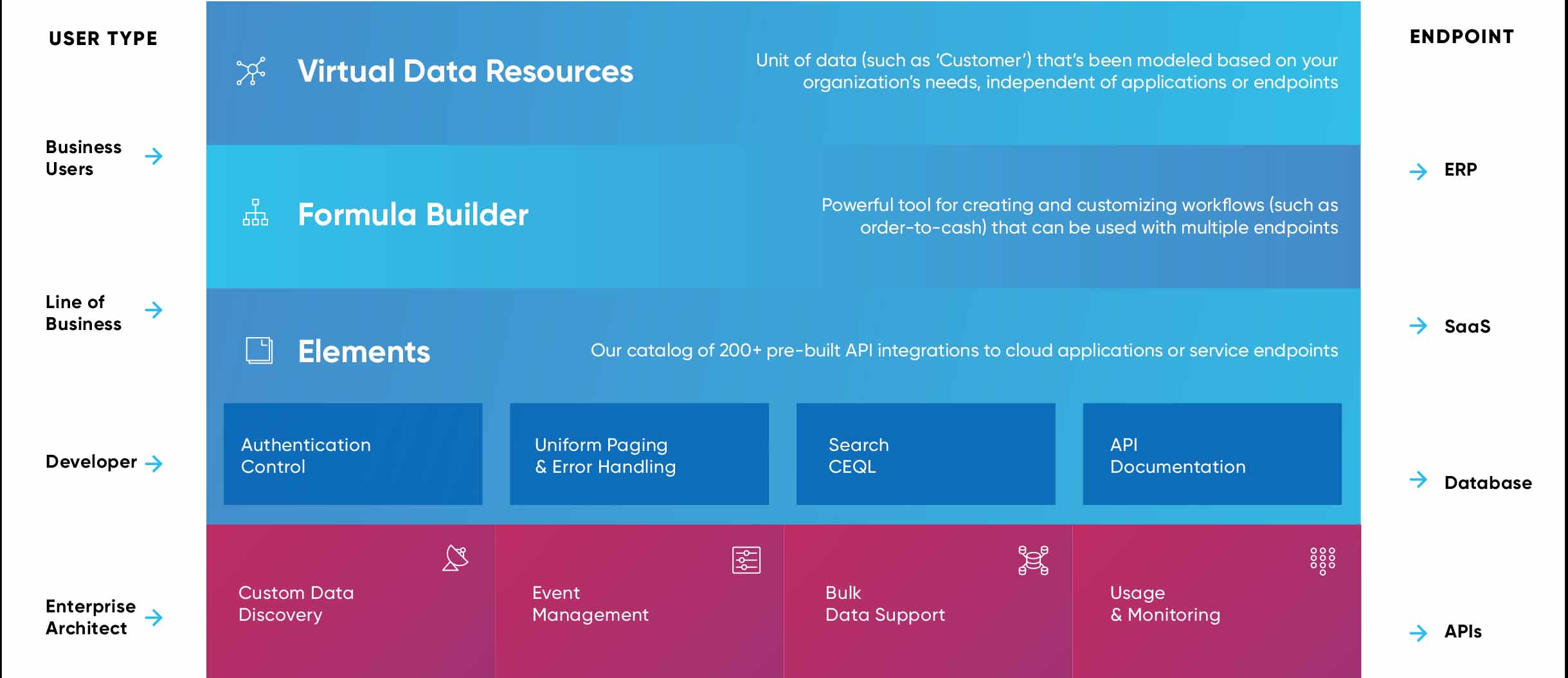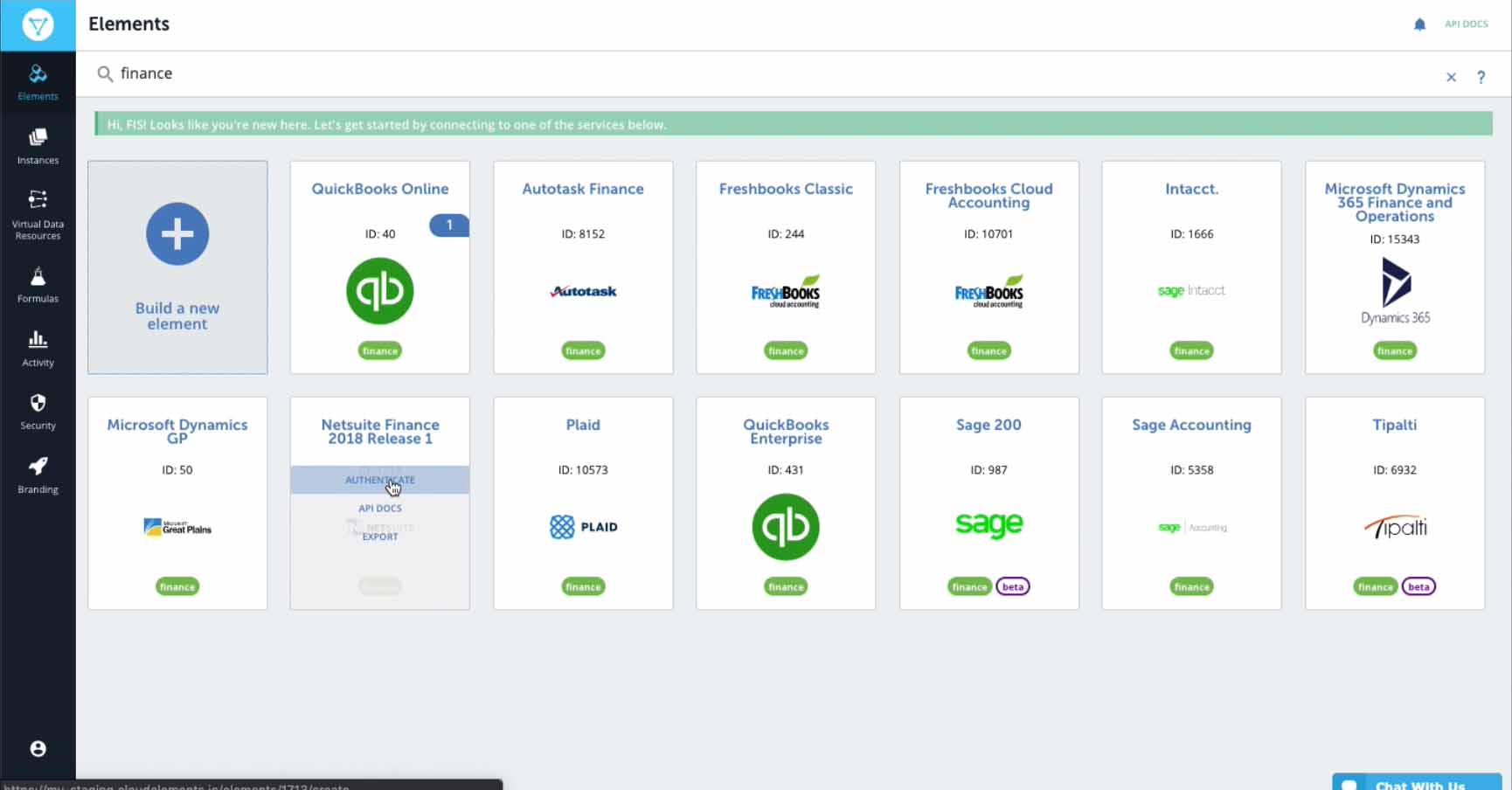Cloud Elements Simplifies API Consumption with Innovative 'API Virtualization'
Cloud Elements is looking to make it easier to consume and work with APIs -- and all their data behind them -- via an innovative approach to virtualization. IDN speaks with CEO and founder Mark Geene.
by Vance McCarthy
Tags: APIs, apps, Cloud Elements, data objects, integration, REST, virtualization, workflow,

ceo

"Point-to-point integration for [consuming] APIs was wonderful when you only had five apps. But now companies may have 10 apps just in marketing, and that may mean 1,000 APIs. At that scale, you need to make it easier to consume them."
Cloud Elements is looking to make it easier to consume and work with APIs -- and all their data behind them -- via an innovative approach to virtualization.
Cloud Elements 3.0 virtualization allows APIs to work in uniform ways across hundreds of applications. It also puts a company’s data model at the center of their ecosystem, according to Mark Geene, Cloud Elements CEO and co-founder.
The Cloud Elements platform use of virtualization aims to address two big challenges for today’s development teams, Geene said.
1) Reducing the pain, cost, and complexity of integration, which sucks up developer time and distracts from product innovation; and
2) Increasing market opportunity by enabling customers to quickly adopt new software that works with their existing applications, while enabling collaboration across their extended ecosystem of customers, prospects, partners and supply chains.
“Point-to-point integration for [consuming] APIs was wonderful when you only had five apps. But now companies may have 10 apps just in marketing, and that may mean they have 1,000 APIs -- and those are changing regularly,” Geene told IDN. “When you deal with API integration at that kind of scale, we think you need to unify them and make it easier for users to consume them and have them work together better.”
Cloud Elements’ combination of virtualization for APIs and data eliminates the need for developers to conduct many various complex and tedious tasks, he added. Among them, the needs to (a) build point-to-point connections using inconsistent APIs; or (b) perform point-to-point mapping of data to each and every new app, Geene explained.
Geene outlined the core benefits of Cloud Elements’ approach to virtualization in his blog:
Integration needs to become a forethought – and it needs to graduate from the “point to point” legacy approach that simply won’t scale in the cloud era.
By unifying APIs and virtualizing data models, we eliminate the drudgery of point-to-point integration, so software teams can build and deploy faster with fewer headaches. We also change the economics of integration, allowing APIs to work in uniform ways across hundreds of applications. And ultimately, we help our customers create fluid, dynamic, one-to-many “plug and play” digital ecosystems that work for their businesses.
A further benefit is that individual developers (and teams) can also gain more control and ease-of-use for modifying API endpoints and data – when working with individual targets, as well as across multiple systems.
Cloud Elements’ Virtualization Approach is Consumption-Centric
Architecture Summit
 Enterprise-Grade Integration Across Cloud and On-Premise
Enterprise-Grade Integration Across Cloud and On-PremiseIn working with APIs, there are two general groups -- API publishers and API consumers. But even with recent waves of API platform innovation and acquisitions, little has changed for API consumers, Geene said.
“Many important API consumption challenges remain,” he told IDN. “What if I want to do eventing - or trigger something else downstream? What if the API doesn’t have the ability to download 10 million records? What if I only want a portion of the data payload, so that I don’t share salary information?”
There are dozens of other consumer challenges, Geene added, all requiring API knowledge, and often specific knowledge about the domain, the app and the data, he said.
Drilling into ways to best solve the API consumers issues was an epiphany for Geene and his team.
“That’s when the light bulb went on for us. We realized we don’t have to create one single source of truth for everyone. We just have to give customers [access and data] the way they want it. Lots of people have a different point on view on what a customer record should look like,” Geene said.
“Apps and mastering systems also differ. So, we let you invoke your point of view on every API that consumes that object. Further, users can move that data seamlessly to work across multiple apps or ‘master’ datasets,” he added.
The Genesis of Cloud Elements’ Vision for How Virtualization Simplifies API Work
At its core, Cloud Elements’ approach asks the question:
What would be the effect of virtualizing APIs and the data and object models behind those APIs?
The answer was provocative and even profound:
Done correctly, this would create a universal ‘consumption-on-demand’ approach, Geene suggested, because the skills and time required to do integration, data prep and mapping would shrink dramatically. There would be no custom coding. It would mean that the end-to-end services required for API consumption could be uniformly applied. And perhaps best of all, the data and the object model would be independent of the endpoint.
With this question and answer in mind, Geene said he set out at Cloud Elements to tackle three (3) aspects to the challenge of simpler API consumption:
Can I work with APIs in a unified way? Error handling, searching. Don’t make me learn a vendor’s different way.
Can I get APIs to work consistently? Does it have webhooks, for instance (less than 20% do). I’ll want consistent but rich functionality. I may want to apply an eventing use case, for example. Can I do this easily?
How do I get just the data needed? Often API consumers have specific needs and want to use only a select number fields (or the portion of the data model).
The Cloud Elements Platform ‘API Virtualization’ Technologies

There are several keys to Cloud Elements 3.0 ‘virtualization’ approach:
Elements. Elements is how Cloud Elements refers to its pre-built integrations which aim to eliminate much of the hand-coding required to work with APIs.
Geene described it this way: “An ‘element’ makes every API you are working with look like it came from the same application endpoint. It also unified and harmonizes the API, so it behaves consistently – paging and searching are consistent, for example.” Elements offer a rich range of normalized capabilities, including authentication, discovery, search, workflows, error handling and API maintenance. “And this all works the same -- whether JSON, REST or even SOAP,” he added.
Virtual Data Hubs. These provide a normalized view of data objects, such as “accounts” or “orders” or “payments,” which allow users to easily access, integrate, share and manage just the data they need. Data is optimized the application or business integration being worked on, Geene said. “With the Virtual Data Hub, we don’t change the physical data,” Geene explained. “We are a model repository and we are not storing data.”
Geene provided details of how the VDH works, along with an example:
“The [VDH] provides virtual representations of any object, say ‘customer’ for example. These are independent of any of the hundreds of API endpoints. . . The benefit is you are working with one virtual view of your data that literally doesn’t physically live anywhere. And it can be transformed into a physical representation [for data access and sharing ] and back again into a virtual representation. As a result, a developer instead of mapping that data to all the endpoints – he can just map it to the virtual representation.”
“So, the Virtual Data Hub provides easy access to a VDR resource, and let users view it the way they want to see it. It gets published as a new API itself, so it can be shared. The representation lives in our platform, and you use our data mapping and data transformation tools to make the various transformations to connect / share with data objects.
Formulas. Formulas are workflow templates that automate processes across multiple applications, e.g. “hire to retire,” “order to cash” and specialized workflows in fintech, healthcare, martech, and other ecosystems. Cloud Elements offers a formula builder to speed design and implementation of these.
Conductor. This is a visual GUI to allow non-technical users to build and manage workflow without code. Such “ad hoc integrators” can now easily customize integrations and build workflows (Elements and Formulas) that meet specific customer needs.
The Cloud Elements virtualization capability is fully bi-directional and supports all the API methods. “We talked a lot about API calls to retrieve data. To post data we can also take a post API call /writing. So, you can call the virtual representation or post to the real data.”
Cloud Elements Modernizes API Consumption To Cut Complexity, Boost ROI
To appreciate the Cloud Elements approach, it’s useful to first understand the limitations of today’s app-specific APIs – and how they impose constraints on how enterprise developers work with APIs and data.
Even with APIs based on REST or other standards (or Swagger support), developers often face many time-consuming tasks to control the access they want.
Geene explained it this way:
“Say, I want to take a customer object and have it work with any other app I have that also has a customer object. Traditionally everything was dependent physically on the endpoints. So, if I had a customer object in Salesforce, Salesforce is essentially defining what the customer object looks like. The same with NetSuite, Marketo and other apps that have their definition of a data object is.”
It’s in this context that Cloud Elements customers are not just opening up consistent (less customized) access to their APIs, but to normalize all the app-specific data objects behind an app’s API.
When Geene and his team asked customers how they could improve API consumption, they heard suggestions that could help – as well as what not to do.
“We heard over and over again, where I have a system of record, don’t make me change that. That’s impossible. Instead, just give me the ability to invoke my point of view from my system of record onto other systems,” he said.
The transform from the API to the developer API is done at the edge at the sandbox, Geene said. “A virtualized API doesn’t physically live anywhere – other than it gives me the view of that data I want. I can have multiple views,” he added.
“We don’t change the physical data. We are a model repository, we are not storing data. If you are the publisher of an app or an API, you use the domain model from your own app. Our focus is on consumption,” he said.
These reasons are why Cloud Elements ‘virtual API’ approach is compatible with current API infrastructures, as well as traditional data repositories.
Early Efficiencies for Top Cloud Elements Use Cases

Geene told IDN how customers get started with Cloud Elements:
“Most often they start with an object that came from a system they are already using. If you are the publisher of an app or an API, you use the domain model from your own app,” he said. For example, Cloud Element customers American Express and Western Union have a structure for a ‘vendor payment’ and they have taken their own platform and invoked that on every accounting and commerce system they integrate to.
This approach leverages the fact of the Cloud Elements virtualization approach.
“The representation lives in our platform. When you take a resource [from the Virtual Data Hub] you are essentially creating a new API. That means the API is sharable across the whole enterprise and any specific app or domain transforms that are required are done at the edge – so as to allow all users to customize the API and data object as needed, without impacting the main resources.
Cloud Elements also provides custom tools developers and teams can use to deliver mapping, transformations.
Another Cloud Elements use case is proving valuable and efficient for customers who use multiple data masters.
Having multiple databases serve the company as a master for different sectors, is not that unusual these days,” Geene said, “especially given how many new apps have become systems of record for certain types of data [and data] objects,” Geene said.
“They use NetSuite as the ‘master’ for their Product Data and Salesforce as the ‘master’ for their Customer Data. And, on top of that, each one of those needs to talk to Marketo, which they are using for leads. So, they need to tie them all together. This required a lot of [API] endpoint and data object expertise.” Cloud Elements’ virtualizing approach for APIs and data resources eliminated most of the need for such diverse domain expertise, he added.
In fact, TwentyEighty, a Colorado-based learnings and performance improvement business, many API consumers have unlocked such efficiencies. “With Cloud Elements integration between our CRM and ERP applications, we’ve seen nearly a 60 percent cost reduction when compared to previous manual business processes spend,” according to company CIO Michael Casullo. “Because we’ve integrated from lead to opportunity to invoice, we’re able to recognize revenue much sooner in the cycle.”
London-based Akkroo, provider of an event lead capture tool, is using Cloud Elements to proactively build its digital ecosystem – and capture new customers. “We knew that our ideal customer is already investing in marketing automation and CRM systems. By using Cloud Elements, we have been able to spin up integrations within very short periods, which has been huge for us,” said Andy Higgs, co-founder and chief product officer in a statement. “Because we were able to implement five integrations quickly, we now cover 90 percent of the market of systems that our customers use.”
Cloud Elements 3.0 includes more than 200 pre-built integrations for a broad array of cloud applications and services, including ERP, CRM, human capital, finance, e-commerce, field service, payments, marketing, messaging, database, storage, and social applications. The latest platform includes new Elements for popular cloud-based ERP (Workday, Oracle, Microsoft Dynamics) and HCM applications (Workday, Oracle, Ultimate Software, Kronos, ADP Payroll).
API Gateways and API Management are complementary to Cloud Elements, and work with most popular products in this space, Geene said.
Related:
- Tray Advantage Program To Speed, Simplify AI-Powered Automation for Enterprises
- Removing Barriers to Business by Enabling Agility & Control with Ecosystem Integration
- 98% of Enterprises Struggle To Maintain, Rebuild Integrations for Key Business Apps
- ThreatX Adds API Visibility, Protection Capabilities To Defend Against Real-Time Attacks
- Visibility and Transparency are Climbing the List of C-Suite Priorities in 2022
All rights reserved © 2025 Enterprise Integration News, Inc.


